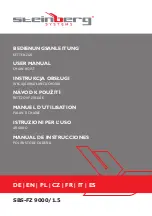
MAN16MG05
instructions
for
use
series
drh
1/2/3/4 -
dst
/
n
/
s
-
dst
/
r
-
drt
74
5.2.1 Operating environment
• The operating environment must have the following characteristics:
•
temperature:
min. –10°C; max. +40°C, max. relative humidity 80%, maximum altitude 1000 m above sea level.
•
indoor use:
as the hoist is not exposed to atmospheric conditions no particular precautions need be taken.
•
outdoor use:
the hoist may be exposed to atmospheric conditions during and after use. The electric parts of the
hoist and trolley have IP55 protection, however, protecting the hoist and trolley with a shelter of some kind is
recommended (fig. 106).
To avoid oxidation protect the structure by using a suitable treatment and lubricating the mechanisms.
5.2.2 Danger zones and people exposed to risk
Danger zones are all areas, in any operative phase, where the people present can be subjected to a risk which
constitutes a danger for their safety, health or psychophysical integrity. It is necessary to inform the
people potentially
exposed, that the hoist operator does not always work with sufficient visibility to prevent all potential risks of crushing,
hitting and dragging. These people must, therefore, take care to avoid exposing themselves to such risks during
manoeuvres in these areas (fig. 107).
In the standard version the hoist must not be used in environments or areas:
• With highly corrosive and/or abrasive vapours, smoke or dust (when this cannot be avoided intensify
the maintenance cycles).
• Where there are flames and/or heat above the temperature permitted.
• With risks of fire or explosion and where flameproof and spark-proof components are required.
•
Where strong electromagnetic fields are present which can generate an accumulation of electrostatic
charge.
• In direct contact with loose foodstuffs.
The purchaser must adequately signal danger zones to forbid or limit access by outside people or
unauthorised staff in the areas where the hoist operates, as outlined by the current regulations in
force.
fig. 106
fig. 107
5.2
Operating conditions
75
instructions
for
use
series
drh
1/2/3/4 -
dst
/
n
/
s
-
dst
/
r
-
drt
MAN16MG05
5.2.3 Illumination of the work area
The DRH electric rope hoist and relative trolley do not have their own lighting system. Therefore, the work place of
the hoist operator must be adequately illuminated in order to guarantee maximum visibility.
5.2.4 The operator
The operators
are all those who, from time to time, perform the following activities on the hoist:
• transportation, handling, assembling, installation, regulation and testing
• starting, use, cleaning, maintenance and repair
• disassembly, dismantling, and demolition
•
The operators
must be people suited to the work and psychophysically able to cope with the demands connected
to the activities related to the hoist during all operative phases and in particular during the slinging and handling
phases.
•
The hoist operator
must position himself so as not to compromise his own safety, foreseeing and/or preventing
and, therefore, avoiding possible dropping of the load being transported, and dangerous movements. He must
follow the specifications supplied to ensure maximum safety for himself and for others during use of the machine,
in particular, he must strictly adhere to the specifications contained in this manual.
5.2.5 The lifting capacity of the hoist
The lifting capacity
of the hoist, in its original operative configuration, is clearly indicated on a plate attached to it
and also to the hook block and is visible from the command post.
• The operator must not let anybody come near during the handling of the hoist and
forbid the use to external people, in particular to people under 16 years of age.
• The use of the hoist is forbidden to non-authorised or untrained people.
• The operator must use suitable personal protection devices (D.P.I. = gloves, protective
footwear).
• The level of illumination must guarantee the maximum level of safety possible for the
operation of the hoist (fig. 108).
• The installation of a supplementary lighting system is obligatory in zones with
insufficient illumination, avoiding shadows which impede or reduce visibility in the
operative and/or neighbouring areas.
The loading capacity of the hoist and its accessories must never be overcome by applying overloads
or modifying the settings of the loading limitator (fig. 109).
fig. 108
fig. 109
KMAN16MG05
Summary of Contents for DRH 1 Series
Page 128: ...KMAN16MG05...
Page 129: ......







































